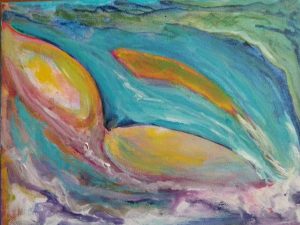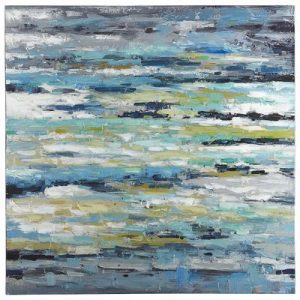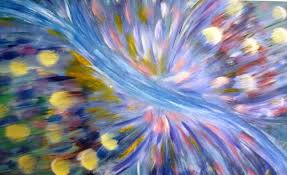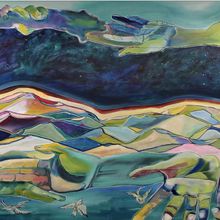Our Moving into Meditation class continues to draw inspiration from hospice counselor and author Frank Ostaseski and poets Danna Faulds and Thich Nhat Hanh. Danna is the other of six books of poetry. You can find more of her inspiration at her Kripalu Center staff site.
Poets and healers seem to convey the “suchness” of meditation by painting auditory images that evoke feelings beyond words.
Guided Relaxation
Welcome . . . . feel yourself enter this river of sensation ceaselessly vibrating… tingling… flowing… let it live through you. . . . Completely relax within this ever changing dance of sound and sensation.
Zen poet and peace activist, Thich Nhat Hanh writes:
 Our body is river in which every cell is a drop of water, and all of them are in constant transformation and movement. There is also a river of feelings in us, in which every feeling is a drop of water. Each of these feelings – pleasant, unpleasant, neutral – relies on all other feelings to be born, mature, and disappear.
Our body is river in which every cell is a drop of water, and all of them are in constant transformation and movement. There is also a river of feelings in us, in which every feeling is a drop of water. Each of these feelings – pleasant, unpleasant, neutral – relies on all other feelings to be born, mature, and disappear.
A river of feeling runs through us . . . Joyful . . . painful . . . calm . . . arising . . . subsiding . . . flowing one into another . . . moment by moment . . . we can feel the current sometimes as a pull . . . a ripple . . . a wave . . .
 In meditation we bring mindfulness to feelings . . . gradually coming to realize how feeling tones condition our mind-states – emotions and thoughts. We can feel their expression in our heart beat . . . our body temperature . . . our breathing . . . When we bring mindfulness to feelings and emotions, we bring awareness to the flow of experience, without being carried away by it, without trying to force it to be different, without trying to escape from it. Entering the stream – just as it is – requires courage . . . a radical willingness – to feel loss – the experience of losing moving unpredictably with the river of living experience coursing through our lives and finally the loosening of our grip on controlling that which cannot be controlled.
In meditation we bring mindfulness to feelings . . . gradually coming to realize how feeling tones condition our mind-states – emotions and thoughts. We can feel their expression in our heart beat . . . our body temperature . . . our breathing . . . When we bring mindfulness to feelings and emotions, we bring awareness to the flow of experience, without being carried away by it, without trying to force it to be different, without trying to escape from it. Entering the stream – just as it is – requires courage . . . a radical willingness – to feel loss – the experience of losing moving unpredictably with the river of living experience coursing through our lives and finally the loosening of our grip on controlling that which cannot be controlled.
Allow (Danna Faulds)
There is no controlling life.
Try corralling a lightning bolt,
 containing a tornado. Dam a
containing a tornado. Dam a
stream and it will create a new
channel. Resist, and the tide
will sweep you off your feet.
Allow, and grace will carry
you to higher ground. The only
safety lies in letting it all in
the wild and the weak; fear,
fantasies, failures and success.
When loss rips off the doors of
the heart, or sadness veils your
vision with despair, practice
becomes simply bearing the truth.
In the choice to let go of your
known way of being, the whole
world is revealed to your new eyes.
From “Go In and In: Poems from the Heart of Yoga”
Frank O. writes that . . . “It is a most beautiful and difficult thing to be human.”
He describes: “Mindfulness as a de-conditioning. It cultivates a merciful, awake presence of mind that no longer blocks the heart. Then things are free to be as they are. We allow the difficult, dark, and dense. We become more intimate with our pain and difficulties, our joy and beauty, embodying our full humanity and discovering an ever-deeper, vast sense of wholeness.
. . . your thoughts and emotions are not who you are. They pass through you, but they are not you. . . . “
When grief arises – in the spaciousness of mindfulness – we can ask ourselves:
. . . is there any part of ourselves that can be present with our sadness? Can we find a more spacious part of ourselves – and if possible – can we place our attention on the relationship between the sadness and this newfound openness?
 Through this loving attention we come to realize that we don’t have to express or repress our experience – we can simply let it be in the space of our awareness. We can hold our experience in a caring way – remaining curious about our experience – exploring the felt sensation in our bodies . . . growing our capacity to gently hold ever changing experiences and perspectives . . .
Through this loving attention we come to realize that we don’t have to express or repress our experience – we can simply let it be in the space of our awareness. We can hold our experience in a caring way – remaining curious about our experience – exploring the felt sensation in our bodies . . . growing our capacity to gently hold ever changing experiences and perspectives . . .
 Frank O. suggests: “Breathing sensing and bringing mindfulness to the physical experience stabilizes our attention and allows the body to become a safe container in which emotions can be embodied . . . We can re-evaluate the automatic negative response and possibly even reinterpret our perceptions of events to discover a new meaning that helps us relate to our emotions in a constructive way. We realize that we have a choice to turn in a healthy direction . . . bring patience and kindness to our reactivity. . . . “
Frank O. suggests: “Breathing sensing and bringing mindfulness to the physical experience stabilizes our attention and allows the body to become a safe container in which emotions can be embodied . . . We can re-evaluate the automatic negative response and possibly even reinterpret our perceptions of events to discover a new meaning that helps us relate to our emotions in a constructive way. We realize that we have a choice to turn in a healthy direction . . . bring patience and kindness to our reactivity. . . . “
Frank writes: “grief is our common ground. It is a connective tissue that joins us together. . . . none of us is exempt from loss. Each of us has our grief. . . . every new loss triggers the memory of another. . . . . grief has been our companion for a good part of our lives. . . . every day grief, the response to the multiple losses and little deaths that occur almost daily . . . the loss of our vitality or a physical or mental capacity, the loss of control, the loss of our dreams. Everyday grief arises when we remember how the carelessness of our actions has caused harm to others. It comes in the moments of not being recognized, at times when our expectations aren’t met. Sometimes our grief is about what we’ve had and lost, and sometimes it is about what we never got to have in the first place. . . . Grief is like a stream running through our lives . . . “
 Time and loving attention heal . . we listen to ourselves . . . we bear witness to one another. . . . living expressions of compassion and kindness . . . Consistent loving attention can melt our defenses and free us from old holdings – the thoughts, physical sensations, emotional turmoil . . . can be held in the the comfort of our awareness. We meet the person we are becoming . . . again and again . . . newly born after meeting each experience fully – alive and whole on our journey.
Time and loving attention heal . . we listen to ourselves . . . we bear witness to one another. . . . living expressions of compassion and kindness . . . Consistent loving attention can melt our defenses and free us from old holdings – the thoughts, physical sensations, emotional turmoil . . . can be held in the the comfort of our awareness. We meet the person we are becoming . . . again and again . . . newly born after meeting each experience fully – alive and whole on our journey.
River
Like the water
in a river
people
are meant to
touch our lives
briefly
and flow their way.
But some people
patiently
cut through
the rocky obstacles
in your life
and teach you
to flow. ~ Poet Harshada Kavi

